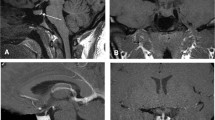Abstract
Aggresssive pituitary tumors are defined as radiologically invasive, exhibiting a rapid growth and a poor response to the medical and surgical treatment options. The role of magnetic resonance imaging (MRI) is fundamental to assess tumor aggressiveness before surgical exploration. Distinction between cavernous sinus invasion and cavernous sinus compression is often challenging and cannot be solved always by using the Knosp criteria. Ideally, T2W images demonstrating the ruptured internal dural wall of cavernous sinus is the ultimate proof of cavernous sinus invasion. Subtle tumor volume increase in a short time can be shown when sequential MR images are rigorously replicable. A microcystic pattern observed on T2W images frequently reflects a potentially aggressive tumor as observed in silent corticotroph pituitary adenomas.












Similar content being viewed by others
References
Chatzellis E, Alexandraki KI, Androulakis II, Kaltsas G Aggressive pituitary tumors, Neuroendocrinology. 2015;101(2):87–104. https://doi.org/10.1159/000371806 Epub 2015 Jan 5 Review.
Lasolle H, Ilie MD, Raverot G. Aggressive prolactinomas: how to manage? Pituitary. 2020 Feb;23(1):70–7. https://doi.org/10.1007/s11102-019-01000-7 Review.
Bonneville JF. Magnetic resonance imaging of pituitary tumors. Front Horm Res 2016;45:97–120. https://doi.org/10.1159/000442327. Epub 2016 Mar 15.
Cottier JP, Destrieux C, Brunereau L, Bertrand P, Moreau L, Jan M, et al. Cavernous sinus invasion by pituitary adenoma: MR imaging. Radiology. 2000;215(2):463–9.
Sol YL , Lee SK, Choi HS, Lee YH, Kim J, Kim SH. Evaluation of MRI criteria for cavernous sinus invasion in pituitary macroadenoma J Neuroimaging. 2014 Sep-Oct;24(5):498–503. https://doi.org/10.1111/j.1552-6569.2012.00710.x. Epub 2012 Nov 15.
Bonneville JF, Cattin F, Racle A, Bouchareb M, Boulard D, Potelon P, et al. Dynamic CT of the laterosellar extradural venous spaces. AJNR Am J Neuroradiol. 1989 May-Jun;10(3):535–42.
Knosp E, Steiner E, Kitz K, Matula C. Pituitary adenomas with invasion of the cavernous sinus space: a magnetic resonance imaging classification compared with surgical findings. Neurosurgery. 1993;33:610–7.
Micko ASG, Wöhrer A, Wolfsberger S, Knosp E. Invasion of the cavernous sinus space in pituitary adenomas: endoscopic verification and its correlation with an MRI-based classification. Neurosurg. 2015;122:803–11.
Xu XY, Wang RZ, Zhi ZYXZ. Performance of Knosp grade for cavernous sinus invasion of Cushing's disease. Chinese. 2019 Jan 29;99(5):388–90. https://doi.org/10.3760/cma.j.issn.0376-2491.2019.05.014.
Cao L, Chen H, Hong J, Ma M, Zhong Q, Wang S. Magnetic resonance imaging appearance of the medial wall of the cavernous sinus. J Neuroradiol. 2013;40:245–51.
Mooney MA, Hardesty DA, Sheehy JP, Bird R, Chapple K, White WL, et al. Interrater and intrarater reliability of the Knosp scale for pituitary adenoma grading. J Neurosurg. 2017 May;126(5):1714–9. https://doi.org/10.3171/2016.3.JNS153044.
Bonneville JF, Bonneville F, Cattin F, Nagi S, editors. Cavernous sinus invasion in MRI of the pituitary gland. Berlin, Germany: Springer; 2016. p. 77–83.
Bonneville JF. A plea for the T2W MR sequence for pituitary imaging. Pituitary. 2019 Apr;22(2):195–7. https://doi.org/10.1007/s11102-018-0928-9.
Potorac I, Beckers A, Bonneville JF. T2-weighted MRI signal intensity as a predictor of hormonal and tumoral responses to somatostatin receptor ligands in acromegaly: a perspective. Pituitary. 2017 Feb;20(1):116–20. https://doi.org/10.1007/s11102-017-0788-8.
Balogun JA, Monsalves E, Juraschka K, Parvez K, Kucharczyk W, Mete O, et al. Null cell adenomas of the pituitary gland: an institutional review of their clinical imaging and behavioral characteristics. Endocr Pathol. 2015;26(1):63–70. https://doi.org/10.1007/s12022-014-9347-2 CrossRefPubMedGoogle Scholar 1.64.
Brochier S, Galland F, Kujas M, Parker F, Gaillard S, Raftopoulos C, et al. Factors predicting relapse of nonfunctioning pituitary macroadenomas afterneurosurgery: a study of 142 patients. Eur J Endocrinol. 2010;163(2):193–200. https://doi.org/10.1530/eje-10-0255.
Drummond J, Roncaroli F, Grossman A B , Korbonits M. Clinical and pathological aspects of silent pituitary adenomas. J Clin Endocrinol Metab. 2019 Jul; 104(7): 2473–2489. Published online 2018 Jul 17. https://doi.org/10.1210/jc.2018-00688.
Ben-Shlomo A, Cooper O. Silent corticotroph adenomas. Pituitary. 2018;21(2):183–93.
Cazabat L, Dupuy M, Boulin A, Bernier M, Baussart B, Foubert L, et al. Silent, but not unseen: multimicrocystic aspect on T2-weighted MRI in silent corticotroph adenomas. Clin Endocrinol. 2014;81(4):566–72.
Kaltsas GA, Nomikos P, Kontogeorgos G, Buchfelder M, Grossman AB. Clinical review: diagnosis and management of pituitary carcinomas. J Clin Endocrinol Metab. 2005;90:3089–99.
Author information
Authors and Affiliations
Corresponding author
Ethics declarations
Conflict of interest
The authors declare that they have no conflict of interest.
Additional information
Publisher’s note
Springer Nature remains neutral with regard to jurisdictional claims in published maps and institutional affiliations.
Rights and permissions
About this article
Cite this article
Bonneville, J.F., Potorac, J. & Beckers, A. Neuroimaging of aggressive pituitary tumors. Rev Endocr Metab Disord 21, 235–242 (2020). https://doi.org/10.1007/s11154-020-09557-6
Published:
Issue Date:
DOI: https://doi.org/10.1007/s11154-020-09557-6




